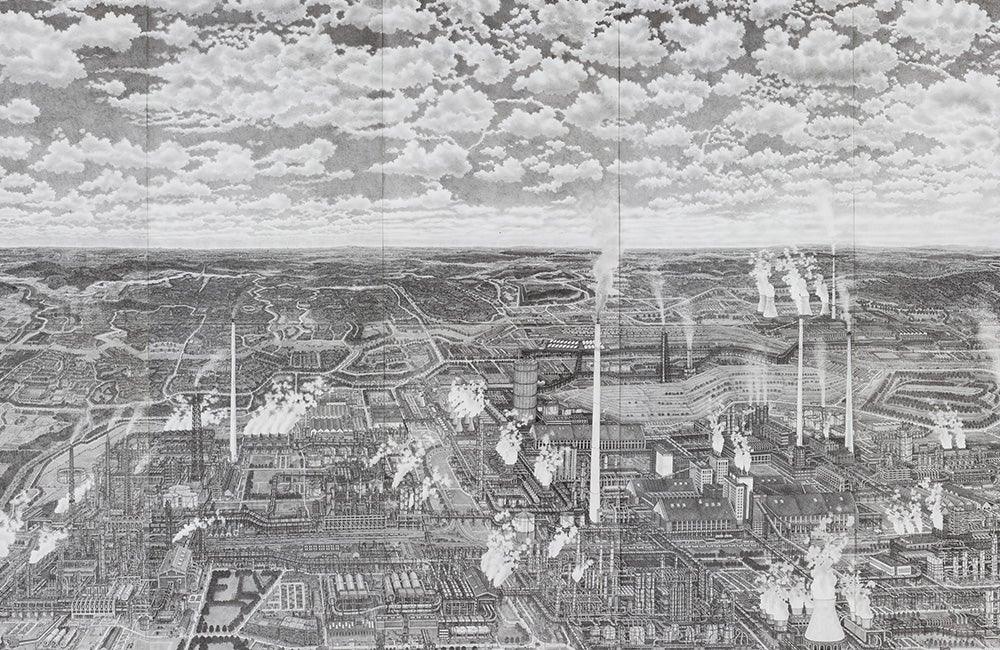First published: Spring 2018
Industrial pipes and steel girders. Smoking chimneys and steamy cooling towers. Rooftop water containers and piled-up storage tanks. Mammoth factory halls, with tiny skylights, access roads and railroad tracks. One roundabout and two rail yards, where in one of which a freight train pulls more than 30 wagons. Transport shafts, sky-high gangways and fire escapes. Cars carpeting parking lots, and countless streetlights, villages and forests. A wide river, crossed with bridges. Meandering creeks. An aeroplane in the sky. These details, and more details, lay themselves out until the horizon, fighting with each other for ones view and marked by a notable absence of humans.

Industry from Above, pencil on paper
Industry From Above is an impressive, hyperrealistic drawing of the DSM chemical plant in Heerlen, southeast Netherlands, as seen through the eyes of it’s creator during his childhood. Whenever visiting his mother’s twin sister, who lives near the factory, or going on vacation to France, the ter Wal family would pass by the plant. The family took no notice of it, apart from Tim. His eyes took in every little detail, recording it in his mind. The plant was archived like a computer file, to be retrieved over two decades later and reproduced elaborately using nothing more than a graphite pencil, a sheet of paper and his mind.
Tim ter Wal is a young Dutch upcoming artist, or, as he calls himself, “a precision draftsman”. His primary inspiration is from industrial architecture and urban landscapes, but animals and the natural world, as well as fantasy worlds with huge dragons, also appear in his drawings. He has long been fascinated by industrial vistas, like the DSM plant. A young ter Wal frequently passed a steelworks in the city of IJmuiden, a port northwest of Amsterdam where his grandfather lived. Twenty-five years later, ter Wal worked only from memory to create a ten-foot-long colour-pencil drawing of the plant, from the perspective of the North Sea Canal’s dyke half a mile away (Panorama Steelworks, not shown). Other sights are stored in his internal picture library, taken from satellite views on Google Earth or mentally recorded through aeroplane windows when he flies to his favourite holiday destination in the Canary Islands. For the past seven years, ter Wal and his father have stayed at the same hotel there several times each year.
“My memory is my camera”, is how ter Wal explains his gift. Recently, he visited the Shell oil refinery at the Botlek, a huge harbour area near Rotterdam. One of ter Wal’s purchasers, and the owner of an extensive private art collection that includes Willem van Genk, offered ter Wal the tour as a present. Although ter Wal has been drawing industrial scenery like this for many years, it was the first time he had actually set foot on such a compound. He said, “A new perspective opened up for me. When looking at images alone my eyes automatically focus on the details but now, while actually walking through it, I can see the big picture and how everything is connected.”
It enabled him to understand how the towers distil the incoming crude oil into various fractions of different boiling ranges, each of which are then processed further in the other refinery processing units. A parallel can be found between the oil refinement processes and those of and ter Wal’s, as the impressions and stimuli that enter his mind during the day are distilled and drained by the act of creating. Drawing the composition. Despite this, he is absolutely confident about what emerges and rarely erases anything.
This is an article extract; read the full article in Raw Vision #97




